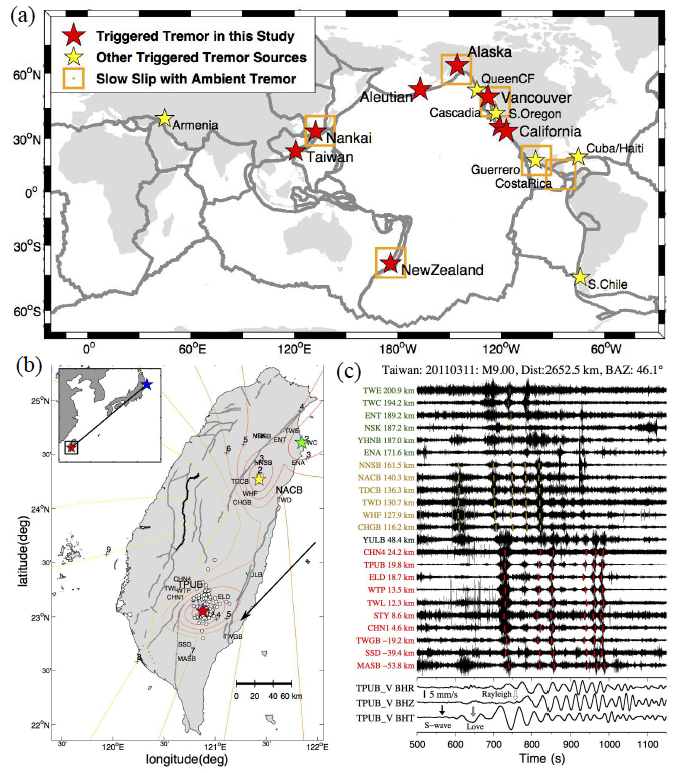2012 IRIS Workshop
Global Observations of Triggered Tectonic Tremor
Kevin Chao: Georgia Tech, Zhigang Peng: Georgia Tech, Hector Gonzalez-Huizar: U.T. El Paso, Chastity Aiken: Georgia Tech, Aaron Velasco: U.T. El Paso
Figure 1. (a) An update map showing regions with episodic tremor and slip (squares) and triggered tremor (star). (b) A map view of the seismic stations and multiple sources of triggered tremor (stars) in Taiwan by the 2011 Mw9.0 Tohoku-Oki, Japan earthquake. (c) The 5 Hz high-pass filtered seismograms showing the moveout of triggered tremor at multiple source regions in Taiwan. The bottom three traces show the broadband seismograms at station TW.TPUB.

Full-resolution graphics file in original format: 0073.png
Deep tectonic tremor and episodic slow-slip events have been observed at major plate-boundary faults around the Pacific Rim (Peng and Gomberg, 2010). These events have much longer source durations than regular earthquakes, and are generally located near or below the seismogenic zone where regular earthquakes occur. Tremor and slow-slip events appear to be extremely stress sensitive, and could be instantaneously triggered by distant earthquakes and solid earth tides. We follow our previous studies and conduct a global search of tremor triggered by recent large teleseismic earthquakes (Chao et al., 2012; Gonzalez-Huizar et al., 2012). We mainly focus on major subduction zones around the Pacific Rim. These include the southwest and northeast Japan subduction zones, the Hikurangi subduction zone in New Zealand, the Cascadia subduction zone, and the major subduction zones in Central and South America. In addition, we examine major strike-slip faults around the Caribbean plate, the Queen Charlotte fault in northern Pacific Northwest Coast, and the San Andreas fault system in California. In each place, we first identify triggered tremor as a high-frequency non-impulsive signal that is in phase with the large-amplitude teleseismic waves. When possible, we locate triggered tremor using a standard envelope cross-correlation technique. We also calculate the dynamic stress and check the triggering relationship with the Love and Rayleigh waves. Finally, we calculate the triggering potential with the local fault orientation and surface-wave incident angles. Our current results suggest that tremor could be triggered at many plate-boundary faults in different tectonic environments. Their triggering behavior could be best explained under the Coulomb-Griffith failure criteria. The apparent triggering threshold is on the order of 1-10 KPa, although this value could be partially influenced by the background noise level or quality and quantity of seismic data.
Acknoweldgements: This work was supported by the National Science Foundation EAR-0956051 (ZP, KC, and CA) and EAR-1053355 (HGH and AV).
For further reading: Chao, K., Z. Peng, H. Gonzalez-Huizar, et al., Global search of triggered tremor following the 2011 Mw9.0 Tohoku-Oki earthquake, Bull. Seismol. Soc. Am., submitted. Gonzalez-Huizar, H., A. A. Velasco, Z. Peng and R. Castro (2012), Remote triggered seismicity caused by the 2011, M9.0 Tohoku-Oki, Japan earthquake, Geophys. Res. Lett., in press. Peng, Z. and J. Gomberg (2010), An integrative perspective of coupled seismic and aseismic slow slip phenomena, Nature Geosci., 3, 599–607. doi: 10.1029/2012GL051015
Keywords: triggered_tremor
